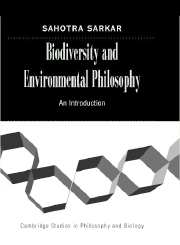Book contents
- Frontmatter
- Contents
- Preface
- Acknowledgments
- Biodiversity and Environmental Philosophy
- 1 Introduction
- 2 Concern for the Environment
- 3 Intrinsic Values and Biocentrism
- 4 Tempered Anthropocentrism
- 5 Problems of Ecology
- 6 The Consensus View of Conservation Biology
- 7 Incommensurability and Uncertainty
- 8 In Conclusion: Issues for the Future
- References
- Index
- References
References
Published online by Cambridge University Press: 17 July 2009
- Frontmatter
- Contents
- Preface
- Acknowledgments
- Biodiversity and Environmental Philosophy
- 1 Introduction
- 2 Concern for the Environment
- 3 Intrinsic Values and Biocentrism
- 4 Tempered Anthropocentrism
- 5 Problems of Ecology
- 6 The Consensus View of Conservation Biology
- 7 Incommensurability and Uncertainty
- 8 In Conclusion: Issues for the Future
- References
- Index
- References
- Type
- Chapter
- Information
- Biodiversity and Environmental PhilosophyAn Introduction, pp. 231 - 250Publisher: Cambridge University PressPrint publication year: 2005



